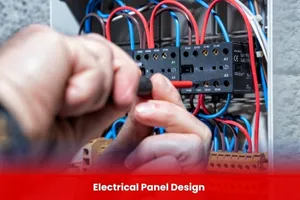Electrical Panel Design
At BURAAQ UK, we specialize in delivering high-quality, innovative, and reliable electrical engineering solutions tailored to meet the needs of a dynamic and evolving industry. Our electrical panel design services form a core part of our offerings, enabling seamless power distribution, control, and automation across various sectors.

Aim of Electrical Panel Design
The aim of BURAAQ UK’s electrical panel design service is to engineer safe, efficient, and cost-effective control and power distribution solutions that meet the specific operational and regulatory requirements of our clients. We strive to deliver high-performance panels that support system reliability, ease of integration, scalability, and long-term maintenance across various applications and industries.
Course Overview
Electrical Panel Design
Educational Qualification
- Minimum Qualification:
- Pass in Class 10 (Secondary School Certificate / Matriculation / GCSE or equivalent)
from a recognized education board.
- Pass in Class 10 (Secondary School Certificate / Matriculation / GCSE or equivalent)
- Subjects Required:
- Mathematics and Science as compulsory subjects (preferred in most institutes).
- Alternative Entry:
- Some institutions allow entry after Class 12 (Higher Secondary) for advanced diploma programs or lateral entry.
- Lateral Entry Eligibility (Direct Entry to 2nd Year)
- Candidates with the following qualifications may get admission directly into the second year of the diploma:
- Class 12 (Science or Vocational stream)
- ITI (Industrial Training Institute) certificate (2-year course in relevant trade)
- Technical high school graduates
- Minimum Marks Requirement
- Varies by country/institution. Typically:
- Minimum 40%–50% aggregate marks in Class 10
- Some reputed institutions may require higher percentages or conduct entrance tests
- Eligibility for International Students
- Equivalent of Class 10/Grade 10 from their home country
- May be required to submit:
- Academic transcripts
- Proof of English proficiency (e.g., IELTS/TOEFL, if taught in English)
| Course Code | Curriculum Title | Credit | DLH |
|---|---|---|---|
| BUK1380-1 | Engineering Mathematics | 2 | 12 |
| BUK1380-2 | Engineering Drawing / Graphics | 2 | 12 |
| BUK1380-3 | Basic Electrical & Electronics Engineering | 2 | 12 |
| BUK1380-4 | Communication Skills / English for Engineers | 2 | 12 |
| BUK1380-5 | Fluid Mechanics & Hydraulic Machines | 2 | 12 |
| BUK1380-6 | Environmental Science & Safety Practices | 2 | 12 |
| BUK1380-7 | Industrial Training / Internship | 2 | 12 |
| BUK1380-8 | Mechatronics or CNC Technology | 2 | 12 |
Learning Objectives
- Engineering Mathematics I
- Engineering Physics
- Engineering Chemistry
- Engineering Drawing / Graphics
- Workshop Practice
- Basic Electrical & Electronics Engineering
- Computer Fundamentals / IT Skills
- Communication Skills / English for Engineers
- Applied Mechanics
- Strength of Materials
- Thermal Engineering
- Fluid Mechanics & Hydraulic Machines
- Theory of Machines
- Manufacturing Technology / Processes
- Machine Tools and Metrology
- Environmental Science & Safety Practices
- Refrigeration and Air Conditioning
- Automobile Engineering (optional/elective in many curriculums)
- Industrial Management & Entrepreneurship
- Computer-Aided Design (CAD)
- Project Work
- Industrial Training / Internship
- Estimation and Costing
- Mechatronics or CNC Technology (in modern curriculums)
- Students After Class 10 (Secondary School)
- Students After Class 12 (Higher Secondary) – Lateral Entry
- International Students
- Working Professionals / Career Changers
- All Modules within this qualification are assessed internally by the approved training Centre and externally verified by BURRAQ UK. The program uses a criterion-referenced assessment approach to ensure that learners successfully meet all required learning outcomes.
- A Pass in any unit is granted only when the learner submits valid, reliable, and authentic evidence that demonstrates achievement of the assessment criteria. The Assessor is responsible for reviewing this evidence and confirming that the learner has attained the expected standard.
